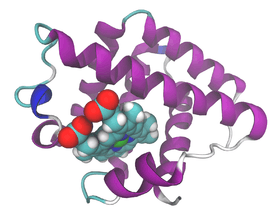Leghemoglobin

Leghemoglobin (also leghaemoglobin or legoglobin) is a nitrogen or oxygen carrier and hemoprotein found in the nitrogen-fixing root nodules of leguminous plants. It is produced by legumes in response to the roots being colonized by nitrogen-fixing bacteria, termed rhizobia, as part of the symbiotic interaction between plant and bacterium: roots not colonized by Rhizobium do not synthesise leghemoglobin. Leghemoglobin has close chemical and structural similarities to hemoglobin, and, like hemoglobin, is red in colour. The holoprotein (protein + heme cofactor) is widely believed to be a product of both plant and the bacterium in which the apoprotein is produced by the plant and the heme (an iron atom bound in a porphyrin ring) is produced by the bacterium.[1] There is some evidence, however, that suggests that the heme moiety is also produced by the plant.[2]
In plants colonised by Rhizobium, such as alfalfa or soybeans, the presence of oxygen in the root nodules would reduce the activity of the oxygen-sensitive nitrogenase - an enzyme responsible for the fixation of atmospheric nitrogen. Leghemoglobin buffers the concentration of free oxygen in the cytoplasm of infected plant cells to ensure the proper function of root nodules. Leghemoglobin has a high affinity for oxygen (Km ~ 0.01 µM), about ten times higher than the β chain of human hemoglobin. This allows an oxygen concentration that is low enough to allow nitrogenase to function but high enough that it can provide the bacteria with oxygen for respiration.
Although leghemoglobin was once thought to provide a buffer for nodule oxygen, recent studies indicate that it stores only enough oxygen to support nodule respiration for a few seconds.[3] Its function is to help provide oxygen to the respiring symbiotic bacterial cells in a manner analogous to hemoglobin transporting oxygen to respiring tissues in animals.[4]
Other plants, like Casuarina sp which is an actinorhizal plant, produce a hemoglobin in their symbiotic root nodules.[5]
See also
References
- ↑ O'Brian MR, Kirshbom PM, Maier RJ (1987). "Bacterial heme synthesis is required for expression of the leghemoglobin holoprotein but not the apoprotein in soybean root nodules". Proc. Natl. Acad. Sci. USA. 84 (23): 8390–8393. doi:10.1073/pnas.84.23.8390. PMC 299548
 . PMID 3479799.
. PMID 3479799. - ↑ Santana MA, Pihakaski-Maunsbach K, Sandal N, Marcker KA, Smith AG (1998). "Evidence that the plant host synthesizes the heme moiety of leghemoglobin in root nodules". Plant Physiol. 116 (4): 1259–1269. doi:10.1104/pp.116.4.1259. PMC 35032
 . PMID 9536042.
. PMID 9536042. - ↑ Denison RF, Harter BL (1995). "Nitrate Effects on Nodule Oxygen Permeability and Leghemoglobin (Nodule Oximetry and Computer Modeling)". Plant Physiol. 107 (4): 1355–1364. doi:10.1104/pp.107.4.1355. PMC 157270
 . PMID 12228439.
. PMID 12228439. - ↑ Ludwig, R. A.; de Vries, G. E. (1986). "Biochemical physiology of Rhizobium dinitrogen fixation". In Broughton, W. J.; Pühler, S. Nitrogen Fixation, Vol. 4: Molecular Biology. Oxford, UK: Clarendon University Press. pp. 50–69. ISBN 0-19-854575-4.
- ↑ Jacobsen-Lyon K, Jensen EO, Jørgensen JE, Marcker KA, Peacock WJ, Dennis ES (1995). "Symbiotic and nonsymbiotic hemoglobin genes of Casuarina glauca". The Plant cell. 7 (2): 213–23. doi:10.1105/tpc.7.2.213. PMC 160777
 . PMID 7756831.
. PMID 7756831.
- Virtanen, A. I. (1948). "Biological Nitrogen Fixation". Annu. Rev. Microbiol. 2 (1): 485–506. doi:10.1146/annurev.mi.02.100148.002413. PMID 18122253.
- Taiz, L.; Zeiger, E. (2006). Plant Physiology Online (3rd ed.). Sunderland, MA: Sinauwr Associates, Inc. p. 269. ISBN 0-87893-856-7. Retrieved 2008-05-03.